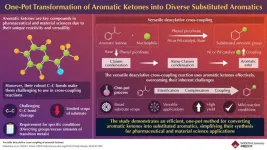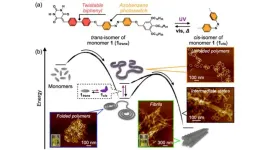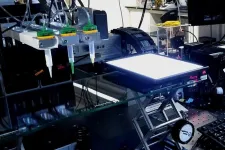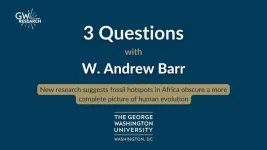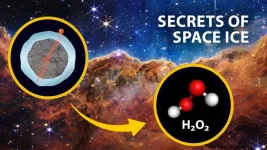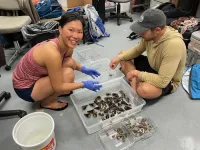(Press-News.org) A newly discovered code within DNA – coined “spatial grammar” – holds a key to understanding how gene activity is encoded in the human genome.
This breakthrough finding, identified by researchers at Washington State University and the University of California, San Diego and published in Nature, revealed a long-postulated hidden spatial grammar embedded in DNA. The research could reshape scientists’ understanding of gene regulation and how genetic variations may influence gene expression in development or disease.
Transcription factors, the proteins that control which genes in one’s genome are turned on or off, play a crucial role in this code. Long thought of as either activators or repressors of gene activity, this research shows the function of transcription factors is far more complex.
“Contrary to what you will find in textbooks, transcription factors that act as true activators or repressors are surprisingly rare,” said WSU assistant professor Sascha Duttke, who led much of the research at WSU’s School of Molecular Biosciences in the College of Veterinary Medicine.
Rather, the scientists found that most activators can also function as repressors.
“If you remove an activator, your hypothesis is you lose activation,” said Bayley McDonald, a WSU graduate student who was part of the research team. “But that was true in only 50% to 60% of the cases, so we knew something was off.”
Looking closer, researchers found the function of many transcription factors was highly position dependent.
They discovered that the spacing between transcription factors and their position relative to where a gene’s transcription began determined the level of gene activity. For example, transcription factors might activate gene expression when positioned upstream or ahead of where a gene’s transcription begins but inhibit its activity when located downstream, or after a gene’s transcription start site.
“It is the spacing, or ‘ambience,’ that determines if a given transcription factor acts as an activator or repressor,” Duttke said. “It just goes to show that similar to learning a new language, to learn how gene expression patterns are encoded in our genome, we need to understand both its words and the grammar.”
By integrating this newly discovered ‘spatial grammar,’ Christopher Benner, associate professor at UC San Diego, anticipates scientists can gain a deeper understanding of how mutations or genetic variations can affect gene expression and contribute to disease.
”The potential applications are vast,” Benner said. “At the very least, it will change the way scientists study gene expression.”
END
Scientists discover new code governing gene activity
2024-08-20
ELSE PRESS RELEASES FROM THIS DATE:
The invasion of Ukraine and European attitudes
2024-08-20
An ongoing survey captures how the Russian invasion of Ukraine affected attitudes in European countries not directly involved in the conflict. Margaryta Klymak and Tim Vlandas examine how the Russian invasion of Ukraine affected economic and political attitudes in eight European countries. The authors took advantage of the timing of the European Social Survey (ESS), which happened to be administered both just before and just after the Russian invasion of Ukraine in February 2022 in eight countries: Switzerland, Greece, Italy, Montenegro, Macedonia, Netherlands, Norway, and Portugal. Overall, the invasion increased support ...
A new reaction to enhance aromatic ketone use in chemical synthesis
2024-08-20
Aromatic ketones have long been valuable intermediates in chemical synthesis, particularly in cross-coupling reactions where different chemical entities are combined to form new compounds. For instance, a process called deacylative cross-coupling removes the acyl group from the aromatic ketone, allowing it to bond with other chemicals and produce a wide variety of useful compounds. These reactions are crucial for producing a wide array of aromatic compounds used in various industries like agrochemicals.
However, the utility of aromatic ketones has been limited due to the difficulty in breaking their strong carbon-carbon bonds. These robust bonds are challenging to cleave, ...
Investigating the interplay of folding and aggregation in supramolecular polymer systems
2024-08-20
In polymers, the competition between the folding and aggregation of chains, both at an individual level and between chains, can determine the mechanical, thermal, and conductive properties of such materials. Understanding the interplay of folding and aggregation presents a significant opportunity for the development and discovery of polymeric materials with tailored properties and functionalities.
This also holds true for non-covalent counterparts of conventional covalent polymers, i.e., supramolecular polymers (SPs). SPs are expected to have practical applications as novel stimuli-responsive ...
Adaptive 3D printing system to pick and place bugs and other organisms
2024-08-20
MINNEAPOLIS / ST. PAUL (08/20/2024) — A first-of-its-kind adaptive 3D printing system developed by University of Minnesota Twin Cities researchers can identify the positions of randomly distributed organisms and safely move them to specific locations for assembly. This autonomous technology will save researchers time and money in bioimaging, cybernetics, cryopreservation, and devices that integrate living organisms.
The research is published in Advanced Science, a peer-reviewed scientific journal. The researchers ...
Fossil hotspots in Africa obscure a more complete picture of human evolution
2024-08-20
WASHINGTON (August 20, 2024) – Much of the early human fossil record originates from just a few places in Africa, where favorable geological conditions have preserved a trove of fossils used by scientists to reconstruct the story of human evolution. One of these fossil hotspots is the eastern branch of the East African Rift System, home to important fossil sites such as Oldupai Gorge in Tanzania. Yet, the eastern branch of the rift system only accounts for 1% of the surface area of Africa—a fact that makes it possible to estimate how much information scientists who rely on such small samples are missing.
In ...
Extraterrestrial chemistry with earthbound possibilities
2024-08-20
DENVER, Aug. 20, 2024 — Who are we? Why are we here? As the Crosby, Stills, Nash & Young song suggests, we are stardust, the result of chemistry occurring throughout vast clouds of interstellar gas and dust. To better understand how that chemistry could create prebiotic molecules — the seeds of life on Earth and possibly elsewhere — researchers investigated the role of low-energy electrons created as cosmic radiation traverses through ice particles. Their findings may also inform medical and environmental applications on our home planet.
Undergraduate student Kennedy Barnes will present the team’s results at the fall meeting of the American ...
Deadly sea snail toxin could be key to making better medicines
2024-08-20
Scientists are finding clues for how to treat diabetes and hormone disorders in an unexpected place: a toxin from one of the most venomous animals on the planet.
A multinational research team led by University of Utah scientists has identified a component within the venom of a deadly marine cone snail, the geography cone, that mimics a human hormone called somatostatin, which regulates the levels of blood sugar and various hormones in the body. The hormone-like toxin’s specific, long-lasting effects, which help the snail hunt its prey, could also help scientists design better ...
Planets contain more water than thought
2024-08-20
We know that the Earth has an iron core surrounded by a mantle of silicate bedrock and water (oceans) on its surface. Science has used this simple planet model until today for investigating exoplanets – planets that orbit another star outside our solar system. “It is only in recent years that we have begun to realise that planets are more complex than we had thought,” says Caroline Dorn, Professor for Exoplanets at ETH Zurich.
Most of the exoplanets known today are located close to ...
Blood platelet score detects previously unmeasured risk of heart attack and stroke
2024-08-20
Platelets are circulating cell fragments known to clump up and form blood clots that stop bleeding in injured vessels. Cardiologists have long known that platelets can become “hyperreactive” to cause abnormal clotting that blocks arteries and contributes to heart attack, stroke, and poor blood flow (peripheral artery disease) in the legs of millions of Americans.
Despite this major contribution to cardiovascular risk, routine measurement of whether each patient’s platelets clump (aggregate) too much has been infeasible to date. ...
New international Pioneer Centre for medical data research
2024-08-20
Can research on diseases as diverse as, for example, diabetes, cardiovascular diseases, psychiatric disorders and endometriosis be linked? The answer is yes if the research focuses on collecting and analysing large amounts of data from both Danish and international registers and biobanks to learn more about, among other things, risk factors, relationships, patterns, treatment and consequences.
And this is exactly what a new international Pioneer Centre, The Pioneer Centre for SMARTbiomed (Statistical and Computational Methods for Advanced Research ...
